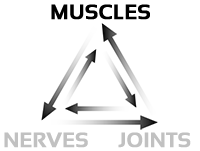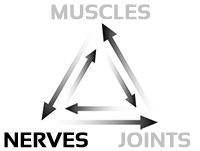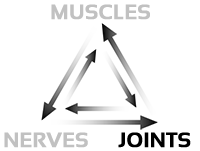Overview:
Headaches are generally caused when the muscles that stabilize the anterior cervical spine and neck become weakened and allow the head posture to migrate forward. As the weight of the head translates forward the tension on the back of the head and neck muscles increase exponentially. As the body fights to stabilize the head position, the joints become locked due to pressure, and muscles become chronically tight and short. With the posterior muscles in a constant shortened and activated state, the smaller anterior neck muscles turn off from being over powered and atrophied from lack of use. The accumulative result is irritation of greater occipital nerve causing chronic headaches.
The Dysfunction:
When the biomechanics of the neck and upper back are altered, inflammation within the individual joint spaces of the spine begins. The inflammatory reaction awakens and sensitizes the nerves that send and receive pain messages. Prior to the onset of pain, unfortunately, warning signs of the problem, such as reduced range of motion are ignored until the pain presents. With limitation in the joint motion one or more of the muscles that move the neck and upper back become short and tight to compensate. With the environment primed for injury, the road from acute or new neck pain to chronic neck pain begins when the muscles that stabilize the anterior cervical spine and neck become weakened and allow the head posture to migrate forward. As the weight of the head translates forward, the tension on the back of the head and neck muscles increases exponentially. As the body fights to stabilize the head position, the joints become locked due to pressure, and muscles become chronically tight and short. With the posterior muscles in a constant shortened and activated state, the smaller, anterior neck muscles turn off from being over powered and atrophy from lack of use. The accumulative result is joints that become stiff and the muscles that move the neck become short and tight, thus reducing the overall pain free range of motion.

Muscles:
Intrinsic-Longus colli, Longus capitis, Rectus capitis anterior, Rectus capitis lateralis
Rectus capitis posterior major and minor, Semispinalis capitis
Extrinsic (Locomotive)– Scalene group, Levator scapulae, Sternocleidomastoid (SCM) , Trapezius

Nerves: Greater Occipital nerve, 5th cranial nerve

Joints: Occiput, Atlas, Axis, Cervical spine, Upper thoracic spine, posterior rib heads, Scapula
Treatment at Intrinsic Chiropractic:
Phase 1: Function and Active Release of Compensatory Muscles and Joint Mobility
The focus of phase one, is for the patient to relearn how to activate the intrinsic stabilizing muscles of the anterior neck and shoulder blades, WITHOUT engaging the large posterior neck or upper back muscles that have been overactive and compensating. Successful completion of this phase will facilitate progression to long term reduction of pain instead of focusing on symptoms only. During this phase, elongation of the movement muscles that have become chronically shorted and tight due to compensation will undergo a treatment called Active Release Technique (ART). During this treatment the muscles are elongated via specific patient motion assisted with focused pressure provided by the doctor.
Phase 2: Strengthening
The focus of phase two is to gain strength in the newly activated intrinsic muscles by performing guided and assisted targeted lifting of the head and shoulder blades. The exercise will be two parts: functional engagement followed by concentric lifting of target muscle.
Phase 3: Neural Integration
The focus of phase three is to return the rehabilitated, intrinsic muscles to the autonomic nervous system control. With the understanding that the autonomic nervous system controls the intrinsic stabilizing muscles without conscience activation and the Somatic nervous system we use to consciously engage our locomotive or prime movement muscles. The only way to train both autonomic Nervous system and the Somatic nervous system is by using exercises that incorporate balance and stability while engaging the large movement muscles. This is achieved by performing the exercises on an unstable surface which forces the brain to activate posture and movement simultaneously.
